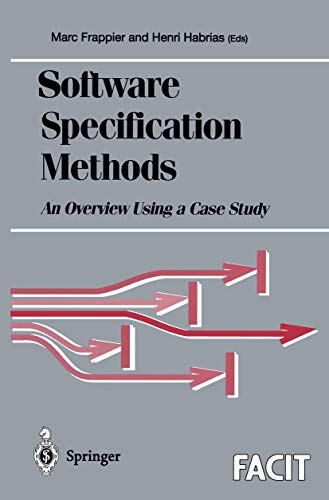software specification methods overview de habrias henri (5 resultados)
Filtros de búsqueda
Tipo de artículo
- Todos los tipos de productos
- Libros (5)
- Revistas y publicaciones (No hay ningún otro resultado que coincida con este filtro.)
- Cómics (No hay ningún otro resultado que coincida con este filtro.)
- Partituras (No hay ningún otro resultado que coincida con este filtro.)
- Arte, grabados y pósters (No hay ningún otro resultado que coincida con este filtro.)
- Fotografías (No hay ningún otro resultado que coincida con este filtro.)
- Mapas (No hay ningún otro resultado que coincida con este filtro.)
- Manuscritos y coleccionismo de papel (No hay ningún otro resultado que coincida con este filtro.)
Condición Más información
- Nuevo (3)
- Como nuevo, Excelente o Muy bueno (1)
- Bueno o Aceptable (1)
- Regular o Pobre (No hay ningún otro resultado que coincida con este filtro.)
- Tal como se indica (No hay ningún otro resultado que coincida con este filtro.)
Encuadernación
- Todas
- Tapa dura (No hay ningún otro resultado que coincida con este filtro.)
- Tapa blanda (5)
Más atributos
- Primera edición (No hay ningún otro resultado que coincida con este filtro.)
- Firmado (No hay ningún otro resultado que coincida con este filtro.)
- Sobrecubierta (No hay ningún otro resultado que coincida con este filtro.)
- Con imágenes (2)
- No impresión bajo demanda (5)
Idioma (1)
Precio
- Cualquier precio
- Menos de EUR 20 (No hay ningún otro resultado que coincida con este filtro.)
- EUR 20 a EUR 45 (No hay ningún otro resultado que coincida con este filtro.)
- Más de EUR 45
Gastos de envío gratis
- Envío gratis a Estados Unidos de America (No hay ningún otro resultado que coincida con este filtro.)
Ubicación del vendedor
Valoración de los vendedores
-
Software Specification Methods: An Overview Using a Case Study
Publicado por Springer Verlag London, London, 2000
ISBN 10: 1852333537 ISBN 13: 9781852333539
Idioma: Inglés
Librería: PsychoBabel & Skoob Books, Didcot, Reino Unido
EUR 46,20
Convertir monedaEUR 10,93 gastos de envío desde Reino Unido a Estados Unidos de AmericaCantidad disponible: 1 disponibles
Añadir al carritoPaperback. Condición: Very Good. Paperback in very good condition. Covers are a little scuffed. Edges, corners and spine ends are slightly bumped and rubbed. Binding is sound and pages are clear. LW. Used.
-
Software Specification Methods: An Overview Using a Case Study (Formal Approaches to Computing and Information Technology (FACIT))
Librería: Ria Christie Collections, Uxbridge, Reino Unido
EUR 111,51
Convertir monedaEUR 13,78 gastos de envío desde Reino Unido a Estados Unidos de AmericaCantidad disponible: Más de 20 disponibles
Añadir al carritoCondición: New. In.
-
Software Specification Methods: An Overview Using a Case Study (Formal Approaches to Computing and Information Technology (FACIT))
Librería: Mispah books, Redhill, SURRE, Reino Unido
EUR 130,32
Convertir monedaEUR 28,76 gastos de envío desde Reino Unido a Estados Unidos de AmericaCantidad disponible: 1 disponibles
Añadir al carritoPaperback. Condición: Like New. Like New. book.
-
Software Specification Methods: An Overview Using a Case Study (Formal Approaches to Computing and Information Technology)
Librería: Revaluation Books, Exeter, Reino Unido
EUR 153,01
Convertir monedaEUR 11,50 gastos de envío desde Reino Unido a Estados Unidos de AmericaCantidad disponible: 2 disponibles
Añadir al carritoPaperback. Condición: Brand New. 282 pages. 9.25x6.00x0.75 inches. In Stock.
-
Software Specification Methods : An Overview Using a Case Study
Librería: AHA-BUCH GmbH, Einbeck, Alemania
EUR 114,36
Convertir monedaEUR 62,38 gastos de envío desde Alemania a Estados Unidos de AmericaCantidad disponible: 1 disponibles
Añadir al carritoTaschenbuch. Condición: Neu. Druck auf Anfrage Neuware - Printed after ordering - Objectives of this Book This book is an introduction to a set of software specification methods. Its tar geted audience are readers who do not wish to read pages of definitions in order to understand the basics of a method. The same case study is used to introduce each method, following a rigorously uniform presentation format. Special care has been devoted to ensure that specifications do not deviate from the case study text. As much as the method allows, what is specified is what appears in the case study text. The benefits are two-fold. First, the reader can easily switch from one method to another, using his knowledge of the case study as a leverage to understand a new method. Second, it becomes easier to compare methods, because the same behavior is specified in each case. Each method presentation follows the same pattern. The concepts are pro gressively introduced when they are needed. To illustrate the specification pro cess, questions that the specifier should raise during the analysis of the case study are stated. Answers are provided as if they were given by an imaginary client. The question/answer process guides the derivation of the specification. Interestingly, the questions raised depend on the method, which is illustrative of the differences between them.




